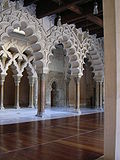
Banu Hud
Encyclopedia

Arab
Arab people, also known as Arabs , are a panethnicity primarily living in the Arab world, which is located in Western Asia and North Africa. They are identified as such on one or more of genealogical, linguistic, or cultural grounds, with tribal affiliations, and intra-tribal relationships playing...
dynasty that ruled the taifa
Taifa
In the history of the Iberian Peninsula, a taifa was an independent Muslim-ruled principality, usually an emirate or petty kingdom, though there was one oligarchy, of which a number formed in the Al-Andalus after the final collapse of the Umayyad Caliphate of Córdoba in 1031.-Rise:The origins of...
of Zaragoza
Zaragoza
Zaragoza , also called Saragossa in English, is the capital city of the Zaragoza Province and of the autonomous community of Aragon, Spain...
from 1039-1110. In 1039, under the leadership of Al-Mustain I, Sulayman ibn Hud al-Judhami
Al-Mustain I
Al-Mustain I, Sulayman ibn Hud al-Judhami was the first member of the Banu Hud family to rule the medieval taifa of Zaragoza, in what is now Spain. He ruled from 1039 to 1049.-References:*...
, the Bani Hud seized control of Zaragoza from a rival clan, the Banu Tujibi
Banu Tujibi
The Banu Tujibi were a dynasty that were appointed to govern Catalayud in 872, and in 886 were given Zaragoza. This they held as governors under the Umayyads...
. His heirs, particularly Ahmad I al-Muqtadir
Ahmad al-Muqtadir
Ahmad ibn Sulayman al-Muqtadir was a member of the Banu Hud family who ruled the Islamic taifa of Zaragoza, in what is now Spain, from 1049 to 1082. He was the son of the previous ruler, Al-Mustain I, Sulayman ibn Hud al-Judhami.-References:*...
(1046-1081), Yusuf al-Mutamin
Yusuf al-Mutamin
Yusuf ibn Ahmad al-Mu'taman ibn Hud was an Arab mathematician and a member of the Banu Hud family, al-Mutamin ruled Zaragoza from 1082 to 1085. He was the son of the previous ruler, Ahmad ibn Sulayman al-Muqtadir...
(1081-1085), and Al-Mustain II, Ahmad ibn Yusuf
Al-Mustain II
Al-Mustain II, Ahmad ibn Yusuf was the final member of the Banu Hud family to rule Zaragoza. He ruled from 1085-1110. He was the son of Al-Mustain II, Ahmad ibn Yusuf....
(1085-1110), were patrons of culture and the arts: the Aljafería
Aljafería
The Aljafería Palace is a fortified medieval Islamic palace built during the second half of the 11th century in the Moorish taifa of Zaragoza of Al-Andalus, present day Zaragoza, Spain. It was the residence of the Banu Hud dynasty during the era of Abu Jaffar Al-Muqtadir after abolishing Banu...
, the royal residence erected by Ahmad I, is practically the only palace from that period to have survived almost in its entirety.
Despite their independence, the Banu Hud were forced to recognize the superiority of the Kingdom of Castile
Kingdom of Castile
Kingdom of Castile was one of the medieval kingdoms of the Iberian Peninsula. It emerged as a political autonomous entity in the 9th century. It was called County of Castile and was held in vassalage from the Kingdom of León. Its name comes from the host of castles constructed in the region...
and pay parias
Parias
In medieval Spain, parias were a form of tribute paid by the taifas of al-Andalus to the Christian kingdoms of the north...
to it as early as 1055. In 1086, they led the smaller kingdoms in their resistance to the Almoravids, who did not succeed in conquering Zaragoza until May 1110. The conquest represented the end of the dynasty. The last of the Banu Hud, Imad al-Dawl abd al-malik al Hud, the last king of Zaragoza, forced to abandon his capital, allied himself with the Christian Aragonese under Alfonso el Batallador, who in 1118 reconquered the city for the Christians and made it the capital of the Kingdom of Aragon
Kingdom of Aragon
The Kingdom of Aragon was a medieval and early modern kingdom in the Iberian Peninsula, corresponding to the modern-day autonomous community of Aragon, in Spain...
.

